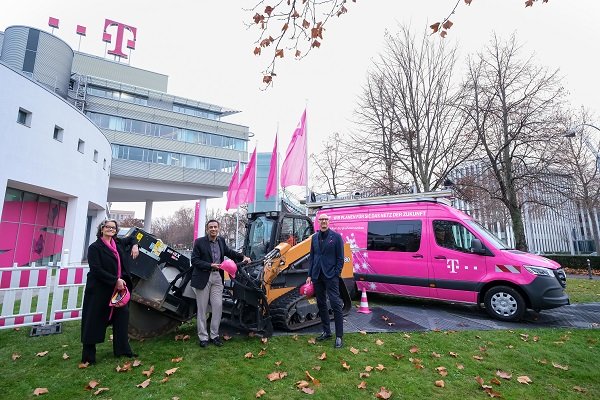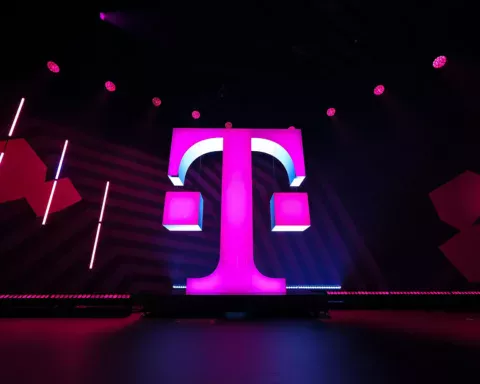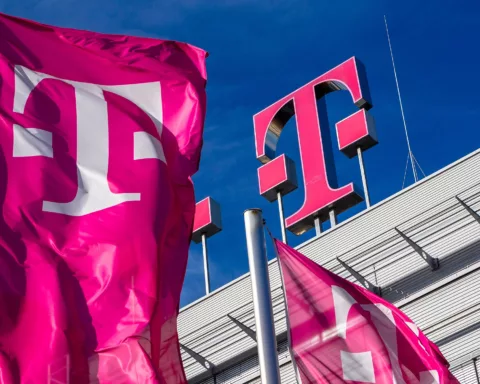This year, Deutsche Telekom has doubled the number of households that can receive FTTH to more than half a million. In the future, this number is set to increase to around two million households per year. Telekom’s goal is to ensure that all households in Germany have direct access to the fiber-optic network by 2030, with the Group making by far the largest contribution towards this. Telekom is now setting the course for this and is focusing on investments, innovations and cooperation.
In mobile communications, 5G is the broadband engine. Two thirds of people in Germany can now use 5G on the Telekom network. 45,000 antennas are already transmitting on 5G. Here too, Deutsche Telekom intends to continue expanding rapidly. In the coming year, the 80 percent mark for population coverage is to be reached with 5G. By 2025, it should be 99 percent – as announced.
“Telekom keeps its promises. This applies in particular to network expansion. Right now, the Telekom network is proving its worth. It was the right decision to put fiber optic in every street and thus to enable fast networks from Telekom for over 80 percent of all households. Home offices are possible throughout the country. Now comes the next step: Fiber optic to the home and 5G. Here too, we have a plan that we are working through step by step. Despite Corona, our expansion is running at full speed,” says Deutsche Telekom CEO Tim Höttges. “And to make sure that everyone in Germany is part of it in the future, we are now really getting going. To achieve this, we have been investing around five and a half billion euros a year in Germany for years. Most of it will go into our network”.
High blow rate for fiber optic expansion
This year, Telekom has already made it possible for around 600,000 households to use fiber optic connections. That is more than twice as many as in the previous year (270,000). In total, Telekom now offers two million households an FTTH connection. Around two million more are to be added annually on average from 2021. The Group is thus massively increasing the rate of expansion. The automation of expansion processes and cooperation with partners will take on a new dimension. But good investment conditions are also important for this. In this context, Deutsche Telekom welcomes the consumer protection demand to abolish the Service charge privilege. After all, freedom of choice for tenants ensures better competition for state-of-the-art technology and good prices.
“We are building for digitization in Germany. The better the framework conditions for investment, the smoother the fiber-optic expansion will run. New technology and new times also require new and flexible answers,” says Tim Höttges. “What additionally helps us with the expansion are, for example, quick approvals. On the other hand, the acceptance of alternative laying methods beyond civil engineering would simplify and accelerate many things. But it also requires a clear commitment from the competition to FTTH. This is a task for society as a whole that we must tackle together. We too have learned our lesson and are focusing much more strongly on cooperation, especially with local suppliers”.
13,000 employees build for the Fiber Factory
In the future, in addition to laying fiber optic cables, the focus will be on producing fiber optic connections in large quantities. This will create a fiber optic factory, the so called Fiber Factory. The associated scaling of the processes is necessary to realize the planned increases. This is because FTTH expansion will continue at a much faster pace. Around 13,000 people are employed in Telekom Technik’s Fiber Factory.
“FTTH is the key to the next surge in digitization. We have revolutionized our processes to achieve this,” says Srini Gopalan, member of the Deutsche Telekom Board of Management responsible for Germany. “Our Fiber Factory is now really taking off. This means we are bringing the fiber directly to where it will be needed more and more in the future: In households, businesses and schools. In the city and in the country”.
We are building everywhere
Currently, Telekom has already laid 575,000 kilometers of fiber optics. A large proportion of this is in new development areas. Every year, Deutsche Telekom is on the move in around 2000 new development areas. It connects around 170,000 households. By 2023, 3,000 business parks are also to be connected to the fiber-optic network. Digitization of schools is also important. Deutsche Telekom can already provide 17,000 schools with connections of up to 250 Mbit/s. In the next three years, at least one in four schools is to receive a fiber optic connection from Deutsche Telekom alone.
Joining forces
Deutsche Telekom continues to rely heavily on cooperation with other companies to expand its broadband network. “The digitization of Germany is a task for society as a whole,” says Srini Gopalan, “which is why we must join forces in all areas. We use all forms of cooperation and are already working successfully with partners: from local city network operators to competitors. Only together can we achieve our goal of supplying Germany completely with fiber optics”.
New Speedport Router with built-in fiber optic modem and display
Digitization must reach the living room. This is why Deutsche Telekom is now offering the new Speedport Smart 4 Plus. The Speedport can be connected directly to a fiber optic cable and has an integrated fiber optic modem. The device is also the first router with an OLED display that conveniently displays information on functions. With Wi-Fi 6 the Speedport has the latest WLAN technology on board. Thanks to integrated mesh WLAN technology, the router brings a continuous WLAN signal to all rooms. The Speedport Smart 4 Plus is marketed in conjunction with a new fiber optic connection from Deutsche Telekom at www.telekom.de/jetzt-glasfaser.
A new device is also available for existing Speedports or routers without an integrated fiber optic modem: the new fiber optic modem 2 for flexible connection of a Speedport router to fiber optic connections from Deutsche Telekom. It supports connection bandwidths up to 2 Gigabit/s and is expected to be available in February 2021.
5G: Fastest expansion in the history of mobile communications
Telekom’s 5G network continues to grow steadily. Already two thirds of the population in Germany can use the new technology. In total, the technicians have made around 45,000 antennas fit for 5G.
“Never before have we been able to set up a new network technology faster than now with 5G. The fact that just over a year after the frequency auction, two-thirds of the population can already use 5G is the fastest expansion in the history of mobile communications. Telekom is the 5G engine in Germany. And 2020 was clearly the 5G year,” says Srini Gopalan.
With 5G, Deutsche Telekom is combining expansion in two frequency bands. On the high-reach 2.1 GHz frequency, high mobile bandwidths will be brought to rural areas in particular. For example, the offshore island of Helgoland is now also being supplied with 5G. The 3.6 GHz frequency provides high-speed 5G where many people move around in a small area, such as in large cities. It is now also used at Frankfurt Airport. The technology will also be installed at Berlin’s BER airport. New are also the 5G Highspeed antennas in Bremen, Hanover and Nuremberg. This means that 13 major cities are already benefiting from 5G in gigabit speed.
Every second contract cell phone is a 5G device
5G is arriving for customers. Every second contract or contract extension is currently concluded with a 5G device. Meanwhile, more than 30 devices in Telekom’s portfolio already support 5G.
5G Campus Network for the University Hospital Bonn
Telekom has put a new 5G campus network into operation on the premises of the University Hospital in Bonn. It is the first campus network to operate on the 3.6 GHz frequency. Indoor antennas supply several hospital buildings. 5G will initially be used in radiology. X-rays and MRT images are transmitted via secure mobile radio to several locations of the University Hospital Bonn. In this way, all relevant departments have access to the radiology information without delay. With this support, patients can be treated faster and better.
“Fast availability of data and its secure exchange is the core of our campus networks. Secure, innovative technologies that support people are very important to us,” says Claudia Nemat, Board Member for Technology and Innovation at Telekom. “Overall, the topic of campus networks is gaining momentum. Industry demand for individual mobile communications coverage is high. We currently already have seven campus networks in operation in Germany”.
5G in 2021
In 2021 the 5G expansion of Telekom will continue. Old 3G antennas will become modern and fast with 5G. This means that all UMTS locations in Germany will be upgraded to 5G by mid-year. In the few places where the anchor frequencies do not permit this, LTE will be used. After all, when UMTS is switched off, Deutsche Telekom will have additional spectrum available on the 2.1 GHz frequency, which will then provide a boost for more speed. Overall, Deutsche Telekom wants to supply around 80 percent of the population with 5G by the end of 2021.
Strong partners – strong Deutsche Telekom
Mobile networks are becoming more and more powerful, the customer experience on the net is getting better and better. But in one part of the network – the Radio Access Network (RAN) – the pace of innovation could be even faster. And the diversity of equipment suppliers could be greater. As a pioneer, Deutsche Telekom launched the global Open RAN movement as early as 2016. It founded the xRAN Forum with a small group of leading telcos and ecosystem partners. In 2018, xRAN merged with a related initiative, the CloudRAN community, to form the telco-led O-RAN ALLIANCE. Mission: Further develop specifications to open and cloudify the RAN. To promote a more competitive and vibrant network equipment landscape. Among other things, Telekom is planning the initial implementation of the so-called O-RAN-Town in Neubrandenburg in 2021. In further steps, up to 25 O-RAN-compatible sites in active network operation with 4G/5G technology come together Cooperations with leading manufacturers such as Dell, Fujitsu, NEC, Nokia, Mavenir and others are under discussion.
“Open RAN has gained considerable momentum. The technical standards & interfaces aim at an open and fully interoperable RAN – for even better customer experiences in our networks. We are pleased to have strong partners,” emphasized Claudia Nemat, Chief Technology Officer. “I am particularly pleased that with Nokia we have also been able to win a strong European partner for our cooperation in O-RAN”.






